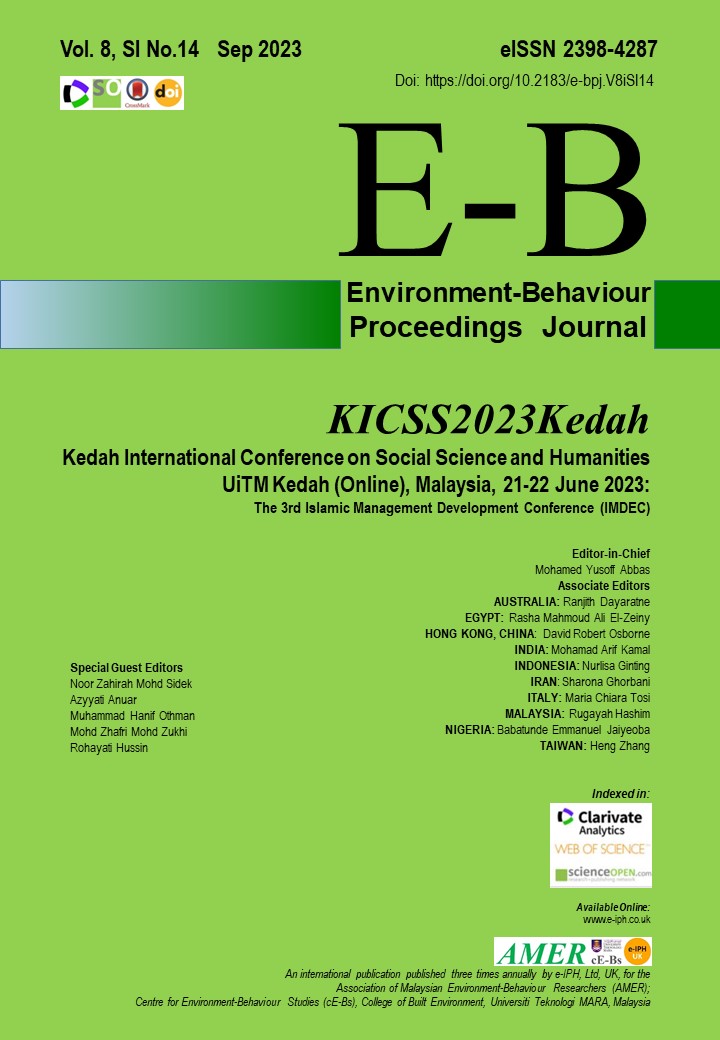Halal Malaysia Brand Image: Analyzing the impact of negative publicities using implicit and explicit measure
DOI:
https://doi.org/10.21834/e-bpj.v8iSI14.5058Keywords:
Halal Malaysia Brand Image, Implicit Association Test, Quasi-Experiment, QualitativeAbstract
Organizations often spend tremendous amounts of money to create a favourable brand image to overcome the competition and maintain the status quo in the market. This study investigates consumers’ valence towards the Halal Malaysia brand and whether consumers’ valence can quickly change after exposure to negative publicities. This study is exploratory, using a mixed method approach of qualitative and quasi-experimental design using an implicit association test (IAT). Findings from the interview showed that most informants are deeply affected by negative publicities due to the sensitive nature of Halal issues to Muslim consumers.
References
Ajzen, I., & Fishbein, M. (2000). Attitudes and the Attitude-Behavior Relation: Reasoned and Automatic Processes. European Review of Social Psychology, 11(1), 1–33. https://doi.org/10.1080/14792779943000116 DOI: https://doi.org/10.1080/14792779943000116
Alserhan, B. A. (2010). On Islamic branding: Brands as good deeds. Journal of Islamic Marketing, 1(2), 101–106. https://doi.org/10.1108/17590831011055842 DOI: https://doi.org/10.1108/17590831011055842
Ataman, B., & Ülengin, B. (2003). A note on the effect of brand image on sales. Journal of Product & Brand Management, 12(4), 237–250. DOI: https://doi.org/10.1108/10610420310485041
Biel, A. L. (1993). Converting Image into Equity. Brand Equity and Advertising: Advertising’s Role in Building Strong Brands. (D. A. Aaker & A. L. Biel, Eds.). New Jersey: Lawrence Elrlbaum associates.
Bland, A. R., & Schaefer, A. (2012). Different varieties of uncertainty in human decision-making. Frontiers in Neuroscience, 6(June), 1–11. https://doi.org/10.3389/fnins.2012.00085 DOI: https://doi.org/10.3389/fnins.2012.00085
Bonne, K., Vermeir, I., Bergeaud-Blackler, F., & Verbeke, W. (2007). Determinants of halal meat consumption in France. British Food Journal, 109(5), 367–386. https://doi.org/10.1108/0070700710746786 DOI: https://doi.org/10.1108/0070700710746786
Chinomona, R. (2016). Brand communication, brand image and brand trust as antecedents of brand loyalty in Gauteng Province of South Africa. Chinomona, Richard. “Brand Communication, Brand Image and Brand Trust as Antecedents of Brand Loyalty in Gauteng Province of South Africa.” African Journal of Economic and Management Studies 7, No. 1 (2016): 124-139., 7(1), 124–139. DOI: https://doi.org/10.1108/AJEMS-03-2013-0031
Creswell, J. W. J., & Clark, V. L. P. V. (2007). Designing and conducting mixed methods research. The Sage Handbook of Qualitative Research, 53–106.
Crouch, M., & McKenzie, H. (2006). The logic of small samples in interview-based qualitative research. Social Science Information, 45(4), 483–499. https://doi.org/10.1177/0539018406069584 DOI: https://doi.org/10.1177/0539018406069584
Cunningham, W. a, Preacher, K. J., & Banaji, M. R. (2001). Research Article Consistency Stability, and Convergent Validity. Psychological Science, 12(2), 163–170. https://doi.org/10.1111/1467-9280.00328 DOI: https://doi.org/10.1111/1467-9280.00328
Easton, V. J., & McColl, J. H. (1997). Statistics glossary (Vol. 1). Retrieved from www.stats.gla.ac.uk/steps/glossary/
Greenwald, A. G., & Farnham, S. D. (2000). Using the Implicit Association Test to measure self-esteem and self-concept. Journal of Personality and Social Psychology, 79(6), 1022–1038. https://doi.org/10.1037/0022-3514.79.6.1022 DOI: https://doi.org/10.1037/0022-3514.79.6.1022
Greenwald, A. G., Nosek, B. A., & Sriram, N. (2006). Consequential validity of the implicit association Test: Comment on Blanton and Jaccard (2006). American Psychologist, 61(1), 56–61. https://doi.org/10.1037/0003-066X.61.1.56 DOI: https://doi.org/10.1037/0003-066X.61.1.56
Keller, K. L. (1993). “Conceptualizing, measuring, and managing customer-based brand equity.” Journal of Marketing, Vol. 57(No. 1), 1–22. https://doi.org/10.2307/1252054 DOI: https://doi.org/10.1177/002224299305700101
Kvale, S. (1996). Interviews: An Introduction to Qualitative Research Interviewing. In Interviews: An Introduction to Qualitative Research Interviewing. (pp. 124-135;144-159). https://doi.org/10.1016/S0149-7189(97)89858-8 DOI: https://doi.org/10.1016/S0149-7189(97)89858-8
Lynn, A., & Lynn, M. (2003). Experiments and quasi-experiments: Methods for evaluating marketing options. The Cornell Hotel and Restaurant Administration Quarterly, 44(2), 75–84. DOI: https://doi.org/10.1177/0010880403442007
Maison, D., Greenwald, A. G., & Bruin, R. (2001). The Implicit Association Test as a measure of implicit consumer attitudes. Polish Psychological Bulletin, 32(1), 1–9. https://doi.org/10.1066/S10012010002
Peltola, N., & Brand, B. C. (2014). Building Customer Based Brand Equity Through Corporate Social Responsibility Case Haglöfs, (April), 1–88.
Shiv, B., & Fedorikhin, A. (1999). Heart and Mind in Conflict: The Interplay of Affect and Cognition in Consumer Decision Making. Journal of Consumer Research, 26(3), 278–292. https://doi.org/10.1086/209563 DOI: https://doi.org/10.1086/209563
Silverman, D. (2013). Doing qualitative research: A practical handbook. SAGE Publications Limited.
Stefanov, S. (2014). The effect of review valence and brand commitment on consumer’s purchase decision.
Stieglitz, S., & Dang-Xuan, L. (2013). Emotions and information diffusion in social media—sentiment of microblogs and sharing behavior. Journal of Management Information Systems, 29(4), 217–248. DOI: https://doi.org/10.2753/MIS0742-1222290408
Tuominen, P. (1999). Customer-Based Brand Equity: Delivering Value for the Firm, Trade. Business, 72–74.
Wan Ismail, W. R., Othman, M., Kamarulzaman, N. H., Abdul Rahman, R., & Rahman, S. A. (2018). “Is sharing really caring?” The impact of eWoM on halal tolerance among Malay Muslim consumers. Journal of Islamic Marketing. https://doi.org/https://doi.org/10.1108/JIMA-04-2016-0035 DOI: https://doi.org/10.1108/JIMA-04-2016-0035
Wilson, J. A. J., & Liu, J. (2011). The challenges of Islamic branding: Navigating emotions and halal. Journal of Islamic Marketing, 2(1), 28–42. https://doi.org/10.1108/17590831111115222 DOI: https://doi.org/10.1108/17590831111115222
Wludyka, P. (2012). Study Designs and Their Outcomes. Epidemiology for Advanced Nursing Practice, 81–114.
Zikmund, W. G., Carr, J. C., Griffi, M., & Babin, B. J. (2013). Business Research Methods. South-Western, Cengage Learning (Vol. 8). https://doi.org/9781285401188
Downloads
Published
How to Cite
Issue
Section
License
Copyright (c) 2023 Wan Rusni Wan Ismail, Nor Hafizah Mazlan, Noraini Rahim, Ahmad Redhuan Abu Bakar

This work is licensed under a Creative Commons Attribution-NonCommercial-NoDerivatives 4.0 International License.





